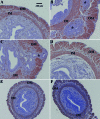Use of a murine endometriosis interna model for the characterization of compounds that effectively treat human endometriosis
- PMID: 22969904
- PMCID: PMC3438689
- DOI: 10.3892/etm.2011.425
Use of a murine endometriosis interna model for the characterization of compounds that effectively treat human endometriosis
Abstract
Endometriosis is a chronic, estrogen-dependent disease characterized by the presence of ectopic endometrium either in the pelvic cavity (endometriosis externa) or within the uterus (endometriosis interna, adenomyosis). Key symptoms are pelvic pain, dysmenorrhea and infertility. Established rodent animal models used for drug research in endometriosis have certain limitations. Since rodents do not menstruate, they cannot develop endometriosis externa spontaneously, but they suffer from endometriosis interna. There is growing evidence that human endometriosis externa and interna represent two faces of the same disease. Both are estrogen-dependent and respond to similar treatment paradigms. Here, we addressed the question whether a murine endometriosis interna model may also be suitable for the characterization of drugs employed in human endometriosis. We examined the effects of danazol, Faslodex and cetrorelix in SHN mice that developed endometriosis interna after pituitary grafting. The GnRH antagonist cetrorelix and the estrogen receptor antagonist Faslodex, which negatively interfered with estrogen-mediated signaling, completely inhibited endometriosis interna, whereas danazol, an androgenic progestin, showed significant therapeutic activity in the majority of SHN mice. We conclude that this murine endometriosis interna model may be a valuable complement to established endometriosis externa models to support drug research in human endometriosis.
Figures


Similar articles
-
The effects of prolactin receptor blockade in a murine endometriosis interna model.Pharmacol Res Perspect. 2022 Feb;10(1):e00916. doi: 10.1002/prp2.916. Pharmacol Res Perspect. 2022. PMID: 35084123 Free PMC article.
-
Endometriosis externa and interna: endoscopic diagnosis.Rays. 1998 Oct-Dec;23(4):683-92. Rays. 1998. PMID: 10191664 English, Italian.
-
Surgical treatment of deep endometriosis with adenomyosis externa: a challenging case in an infertile woman.Fertil Steril. 2021 Apr;115(4):1084-1086. doi: 10.1016/j.fertnstert.2020.11.004. Epub 2021 Mar 6. Fertil Steril. 2021. PMID: 33750620
-
Adenomyosis pathogenesis: insights from next-generation sequencing.Hum Reprod Update. 2021 Oct 18;27(6):1086-1097. doi: 10.1093/humupd/dmab017. Hum Reprod Update. 2021. PMID: 34131719 Free PMC article. Review.
-
Hormonal treatments for adenomyosis.Best Pract Res Clin Obstet Gynaecol. 2008 Apr;22(2):333-9. doi: 10.1016/j.bpobgyn.2007.07.006. Epub 2007 Aug 30. Best Pract Res Clin Obstet Gynaecol. 2008. PMID: 17765017 Review.
Cited by
-
Murine Models and Research Progress on Dysmenorrhea.Reprod Sci. 2023 Aug;30(8):2362-2372. doi: 10.1007/s43032-023-01220-0. Epub 2023 Apr 3. Reprod Sci. 2023. PMID: 37010703 Review.
-
Single-cell RNA sequencing identifies the prolactin receptor as a therapeutic target in adenomyosis.Signal Transduct Target Ther. 2025 Aug 13;10(1):258. doi: 10.1038/s41392-025-02339-z. Signal Transduct Target Ther. 2025. PMID: 40804233 Free PMC article.
-
The effects of prolactin receptor blockade in a murine endometriosis interna model.Pharmacol Res Perspect. 2022 Feb;10(1):e00916. doi: 10.1002/prp2.916. Pharmacol Res Perspect. 2022. PMID: 35084123 Free PMC article.
-
Rodent Models of Experimental Endometriosis: Identifying Mechanisms of Disease and Therapeutic Targets.Curr Womens Health Rev. 2018 Jun;14(2):173-188. doi: 10.2174/1573404813666170921162041. Curr Womens Health Rev. 2018. PMID: 29861705 Free PMC article. Review.
-
Animal Models of Adenomyosis.Semin Reprod Med. 2020 May;38(2-03):168-178. doi: 10.1055/s-0040-1718741. Epub 2020 Oct 26. Semin Reprod Med. 2020. PMID: 33105508 Free PMC article. Review.
References
-
- Leyendecker G, Herbertz M, Kunz G, Mall G. Endometriosis results from the dislocation of basal endometrium. Hum Reprod. 2002;17:2725–2736. - PubMed
-
- Kitawaki J, Kado N, Ishihara H, Koshiba H, Kitaoka Y, Honjo H. Endometriosis: the pathophysiology as an estrogen-dependent disease. J Steroid Biochem Mol Biol. 2002;83:149–155. - PubMed
-
- Benagiano G, Brosens I, Carrara S. Adenomyosis: new knowledge is generating new treatment strategies. Womens Health. 2009;5:297–311. - PubMed
-
- Sampson JA. Peritoneal endometriosis due to the menstrual dissemination of endometrial tissue into the peritoneal cavity. Am J Obstet Gynecol. 1927;14:422–469. - PubMed
LinkOut - more resources
Full Text Sources
Other Literature Sources
Molecular Biology Databases
Research Materials
